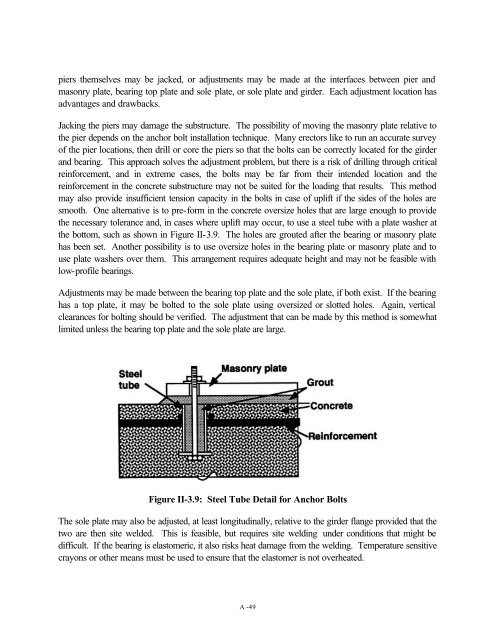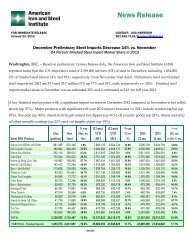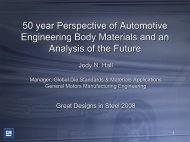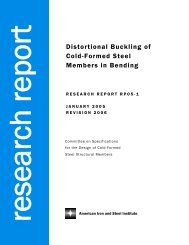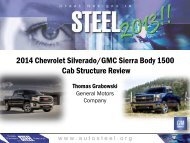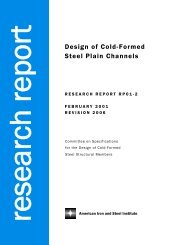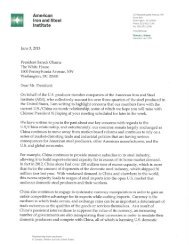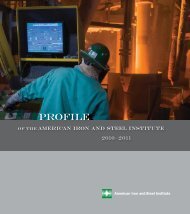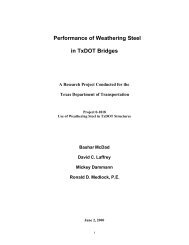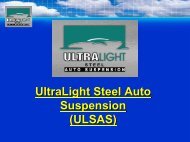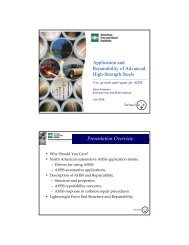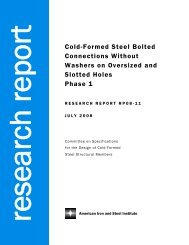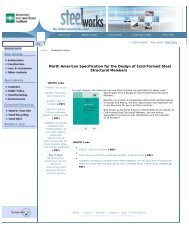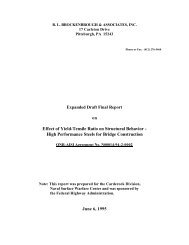Steel Bridge Bearing Selection and Design Guide (Part 3)
Steel Bridge Bearing Selection and Design Guide (Part 3)
Steel Bridge Bearing Selection and Design Guide (Part 3)
You also want an ePaper? Increase the reach of your titles
YUMPU automatically turns print PDFs into web optimized ePapers that Google loves.
piers themselves may be jacked, or adjustments may be made at the interfaces between pier <strong>and</strong><br />
masonry plate, bearing top plate <strong>and</strong> sole plate, or sole plate <strong>and</strong> girder. Each adjustment location has<br />
advantages <strong>and</strong> drawbacks.<br />
Jacking the piers may damage the substructure. The possibility of moving the masonry plate relative to<br />
the pier depends on the anchor bolt installation technique. Many erectors like to run an accurate survey<br />
of the pier locations, then drill or core the piers so that the bolts can be correctly located for the girder<br />
<strong>and</strong> bearing. This approach solves the adjustment problem, but there is a risk of drilling through critical<br />
reinforcement, <strong>and</strong> in extreme cases, the bolts may be far from their intended location <strong>and</strong> the<br />
reinforcement in the concrete substructure may not be suited for the loading that results. This method<br />
may also provide insufficient tension capacity in the bolts in case of uplift if the sides of the holes are<br />
smooth. One alternative is to pre-form in the concrete oversize holes that are large enough to provide<br />
the necessary tolerance <strong>and</strong>, in cases where uplift may occur, to use a steel tube with a plate washer at<br />
the bottom, such as shown in Figure II-3.9. The holes are grouted after the bearing or masonry plate<br />
has been set. Another possibility is to use oversize holes in the bearing plate or masonry plate <strong>and</strong> to<br />
use plate washers over them. This arrangement requires adequate height <strong>and</strong> may not be feasible with<br />
low-profile bearings.<br />
Adjustments may be made between the bearing top plate <strong>and</strong> the sole plate, if both exist. If the bearing<br />
has a top plate, it may be bolted to the sole plate using oversized or slotted holes. Again, vertical<br />
clearances for bolting should be verified. The adjustment that can be made by this method is somewhat<br />
limited unless the bearing top plate <strong>and</strong> the sole plate are large.<br />
Figure II-3.9: <strong>Steel</strong> Tube Detail for Anchor Bolts<br />
The sole plate may also be adjusted, at least longitudinally, relative to the girder flange provided that the<br />
two are then site welded. This is feasible, but requires site welding under conditions that might be<br />
difficult. If the bearing is elastomeric, it also risks heat damage from the welding. Temperature sensitive<br />
crayons or other means must be used to ensure that the elastomer is not overheated.<br />
A -49


